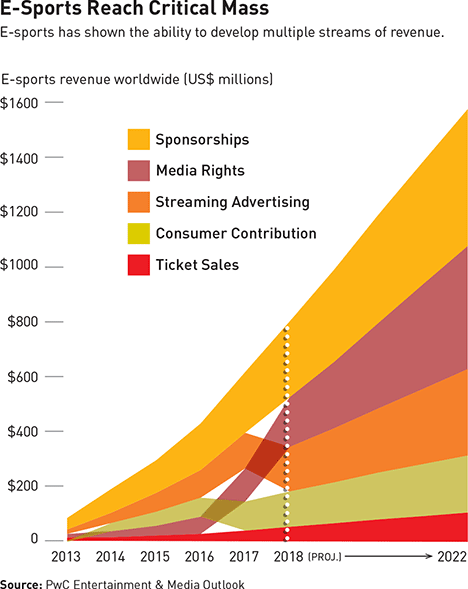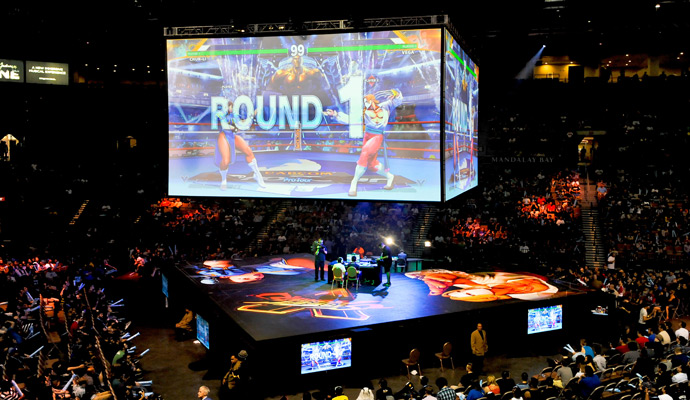Video Gaming Levels Up into a Sport
E-sports evolved from a hobby into an obsession, into a business — and now it is a full-fledged entertainment industry.
Madison Square Garden is known as the world’s most famous arena. The midtown Manhattan home of the New York Knicks and New York Rangers, the Garden has sold out thousands of basketball, hockey, and other sporting events since opening in 1968, along with concerts, circuses, dog shows, political conventions, and even a papal Mass. Yet a pair of back-to-back sellouts in October 2016 heralded not just an entertainment bonanza for the Garden but also a burgeoning global sports phenomenon.
The occasion was the semifinals of the League of Legends World Championship, a multiplayer online battle arena (MOBA) video game. LoL, for short, is the most popular title in competitive video gaming, or e-sports, as it’s known among the nearly 220 million players around the world. It’s one thing to play a video game for hours on end, and quite another to pay to watch people playing video games. On those two nights, 15,000 fans, most of them millennials and younger, packed the Garden — paying upward of US$75 per ticket — and went crazy as they followed the blazing action at center court and on the jumbotron overhead.
The final two teams, both from South Korea, duked it out a week later at a standing-room-only Staples Center in Los Angeles, with the winners splitting the $1 million grand prize. That five-game playoff wrapped up LoL’s monthlong, four-city, $6.7 million total purse tournament, which the company said was live-streamed to an estimated global audience of nearly 400 million. (For comparison, about 1 billion people tuned in to the 2014 World Cup soccer final between Argentina and Germany.)
E-sports has emerged as a force on the entertainment and media landscape slowly — and all at once. As video games evolved from a leisurely pursuit to a full-blown craze, the business model first centered on game publishers, such as Nintendo, Atari, and Electronic Arts, and PCs and gaming consoles. Then, over the past decade or so, gaming innovations, the spread of broadband Internet, and changing consumer habits have seen gaming morph into a vibrant and viable industry of its own. And as a media business, e-sports has a compelling set of attributes. In an era of distraction and short attention spans, e-sports commands the focus of young people who are otherwise shifting away from established modes of media consumption.
The rapid growth and high level of engagement are translating into real money. According to the PwC Global Entertainment & Media Outlook 2018–2022, a comprehensive source of advertising and consumer spending data available on June 6, 2018, total e-sports revenues across 20 countries — comprising sponsorships, media rights, streaming advertising, the consumer contribution to prize pots, and ticket sales — was estimated at $620 million in 2017, up 43.7 percent from $432 million in 2016. That total is forecast to reach $1.6 billion in 2022, rising at a 20.6 percent compound annual growth rate (see “E-Sports Reach Critical Mass”). Newzoo, an Amsterdam-based market research firm, estimates that the worldwide e-sports viewing audience grew in 2017 to 385 million, up nearly 20 percent from 326 million in 2016, and has a projected fan base of nearly 900 million by 2020.
Those revenue and viewership numbers are among the fundamental building blocks in the business model of e-sports as it sidles up alongside America’s Mount Rushmore of sports leagues — the National Football League, the National Basketball Association, Major League Baseball, and the National Hockey League. Although it still has a long way to go to fully join, and compete for revenues with, those big leagues, e-sports is emulating the same growth patterns they experienced on the way to success. “The evidence is there,” contends Rick Burton, the David Falk Professor of Sport Management at Syracuse University. “Every metric shows that the growth of e-sports is going straight up.”
E-sports leagues are forming around professional franchises, teams, and players, and aligning with brand-name video game titles such as LoL, as well as the NBA and FIFA, the international soccer federation. Expanding television and Internet viewership is leading to major media-rights deals, which are convincing more advertisers and sponsors to hop on the bandwagon. The demand for live events is spurring construction of dedicated e-sports venues. And, feeling e-sports nipping at their heels — and not wanting to be left out — traditional sports leagues, teams, owners, and athletes are investing in the industry. “It’s high-level competition that’s wildly entertaining and sells out arenas,” says Darin Kwilinski, senior editor for ESPN’s e-sports group. (Yes, the “worldwide leader in sports” now recognizes and covers the category.)
Evolution of a Sport
Historically, sports have evolved from games and hobbies into organized competition — and then into businesses. Baseball emerged in the 1840s from an earlier bat-and-ball pastime called rounders, and basketball from James Naismith’s notion in 1891 to shoot a soccer ball up and through a peach basket. E-sports is following a similar pattern. It evolved from video games such as Pong and Donkey Kong, rudimentary titles hatched in 1972 and 1981, respectively. The original business model for the game developers was to sell the games and the devices they were played on as consumer products through the electronics and toys retail channel.
Moore’s Law and sequential advances in computing power and graphics unleashed myriad video games enhanced with 3D animation that brought phantasmagorical characters, creatures, and worlds to movie-quality life. They were played on souped-up computers and gaming consoles, mostly Sony’s PlayStation and, later, Microsoft’s Xbox, and increasingly on mobile devices. Gamers played alone or against multiple players anywhere in the world via the Internet. The business evolved to more closely resemble software publishing, with new releases every year.
Next, competitions started to form organically. Competitive video gaming actually dates back to 1972, when Stanford University students staged a team tournament on campus based on the game Spacewar. From there the Internet spread the joy(stick) farther with the expansion of broadband service to carry gaming’s heavy data loads. By the year 2000, online amateur and professional players from all corners of the globe were simultaneously vying to win increasingly sophisticated games. Some games were sports-oriented, starring avatars of popular real-world athletes and teams. Others were so-called shooter games with hordes of fantastical virtual characters fighting hand-to-hand or with gigantic guns and other lethal weaponry, acquiring increased skills as they advanced through levels.
Then, in a step that few predicted, people began to watch others play games. The term e-sports entered the lexicon around the turn of the millennium, along with an even glossier generation of games. Organically, and not as a result of any master business model, fans flocked to organized competitions among professional teams of well-paid players, not only in person but online. Twitch, a video-streaming platform that launched in 2011, was likely the first media business built around gaming. Before Amazon bought it for an eye-catching $970 million in 2014, Twitch had amassed a worldwide audience of more than 55 million viewers, who were glued to 15 billion-plus minutes of content.
Twitch, a video-streaming platform that launched in 2011, was likely the first media business built around gaming.
In 2017, according to esportsearnings.com, the most popular e-sports titles, after LoL, were Call of Duty, Defense of the Ancients 2 (popularly known as Dota 2), Overwatch, and StarCraft — all in the MOBA genre. MOBAs are complex, real-time strategy games, with human players assuming virtual characters, each armed and possessing abilities accumulated during intense battles. Opponents attack one another’s bases, looking to blast their enemies and their home bases into cyber oblivion.
During typical tournament play, five-person teams of gamers, donning headsets and sitting in front of PC keyboards and monitors, compete head-to-head, with play-by-play “casters” calling the live action. Fans, in attendance or online, listen in as teammates continuously communicate with one another, and chat with the players as well. Separately, on social media, star players stream on Twitch and interact with fans. There are also apps that let people create chat rooms where teams or players interact.
Several publicly traded companies develop and publish e-sports titles and other video games. The largest is Tencent Holdings, whose Riot Games division is behind LoL. Activision Blizzard owns Call of Duty, Overwatch, and StarCraft. Take-Two Interactive publishes Grand Theft Auto and the basketball title NBA 2K. Electronic Arts, founded in 1982, has thrived with annually updated sports titles, including Madden NFL and FIFA, both of which are entering the e-sports arena. Smaller, independent publishers are joining the fray, too, such as PUBG Corp., whose PlayerUnknown’s Battlegrounds became an overnight sensation when it was released in late 2017.
The popularity of Twitch and live e-sports streamed on YouTube and broadcast on TBS highlighted the meteoric rise in fan viewership and the particular demographic characteristics of those fans. About 70 percent of the predominantly millennial-aged audience is male, according to Nielsen Esports, a recently created division of the media measurement and analysis firm. They thrive on social media, are avid ad blockers, and don’t watch traditional TV or respond to conventional advertising nearly as much as older generations — which puts them outside the reach of traditional media. Although they are passionate, e-sports fans spend only 17 percent of their leisure time and money on gaming.
By attracting a disproportionate share of the attention of young, predominantly male viewers, e-sports solves one problem for media. Another factor is working in the new industry’s favor: The social and cultural context is changing to make e-sports appealing for participants. Historically, parents have feared the latest teen craze — comic books, rock and roll, TV, smartphones — as the end of civilization. But part of the acceptance of gaming is its relative safety and the availability of parental control. “Over the past several years, there’s been a pronounced discussion about the dangers of playing American football,” says Syracuse’s Burton. Indeed, participation in football nationally among kids ages 6 to 12 fell by nearly 30 percent between 2008 and 2016, according to data from the Sports & Fitness Industry Association. “Throw into that a media and parental orientation that allowing my child to go outside alone or to play unsupervised with friends is a dangerous thing,” Burton says. Now, as millennials — many of whom grew up on video games themselves — start to become parents, e-sports could become a family activity.
Growing Professionalization
In the past few years, e-sports has leveled up toward professionalization. A series of coincident developments is helping to build the talent, infrastructure, and business models that put the sports in e-sports.
Legitimate leagues, franchises, and pro player development have risen up from the grassroots fan base. Video gamers are engaged in season-long, rules-based competitions that culminate in championship tournaments. Publisher-organized leagues have formed around LoL, Counter-Strike: Global Offensive, and Dota 2, whose 2016 international tournament awarded more than $20.7 million in winnings — roughly double the total payout of the Professional Golfers’ Association’s Masters tournament.
In an innovative twist on that model, Activision Blizzard created the first-person shooter game Overwatch, released two years ago, from the ground up as the basis of an e-sports league. Even as it cultivated 35 million global players, the company was selling a dozen franchises, in cities including New York, Dallas, Los Angeles, London, and Seoul, at a reported $20 million each. Investors include New England Patriots owner Robert Kraft, a New York team led by New York Mets COO Jeff Wilpon, a Los Angeles team owned by Denver Nuggets co-owner Stan Kroenke and his son, Josh, and a San Francisco team led by Andy Miller and Mark Mastrov, co-owners of the Sacramento Kings.
The Overwatch League debuted in January, live-streamed on Twitch as part of an exclusive two-year, $90 million media rights deal with Blizzard. The online audience peaked at more than 415,000 viewers on opening night, and rarely dipped below 150,000 at any point during the first week. The first season is being played at Blizzard Arena in Burbank, Calif. — where all 450 seats sold out for the inaugural tourney. But Blizzard anticipates a more traditional sports league model, with in-season games and playoffs rotating among franchise cities.
The number of pro e-sports players is modest compared with those in the big four leagues. But many of the same enticements that spur young people to practice hard and pursue their dreams are there, including six-figure salaries, housing and transportation, coaches, nutritionists, and sports psychologists. According to the latest data from esportsearnings.com, 46 of the top 100 highest-paid e-sports players have accumulated more than $1 million in prize earnings — led by Germany’s 25-year-old Kuro “KuroKy” Takhasomi (every pro has a nickname), at more than $3.5 million. The 100th-highest-earning player has earned at least $575,000, which tops the minimum salary in Major League Baseball ($545,000). (Of course, with the salaries and the fan adulation come some of the downsides of professional sports. Some e-sports players are suffering from carpal tunnel syndrome, and others have abused Adderall.)
Just as with professional sports, talent pipelines are being developed. E-sports has entered the college ranks; more than 50 schools are affiliated with the National Association of Collegiate Esports, some with varsity teams offering scholarships and playing in on-campus e-sports venues. Last year, several members of the Big Ten Conference, which includes Michigan, Maryland, and Rutgers, broadcast a LoL conference tournament on its TV network, reaching a potential 60 million households nationally.
Fields of Dreams
The next leap in legitimizing e-sports has been the development of physical infrastructure for events. In that sense, e-sports is turning the “if you build it, they will come” strategy on its head. Fans are already attending e-sports in droves, but they’re mostly doing so online. Building venues for gaming is a way to make a deeper consumer connection that engenders loyalty in local communities, fuels another layer of intercity sports rivalries, and provides a new platform for sponsorship and advertising. NBA teams are retrofitting their arenas to accommodate the NBA 2K league events. The Milwaukee Bucks are erecting a brand-new “smart” complex to host both their NBA and NBA 2K teams. “We are creating a venue that will have e-sports lounges to play in, and we obviously want our arena to be a destination for tournaments,” says Bucks president Peter Feigin, referring to the $524 million Wisconsin Entertainment and Sports Center, which opens in the fall of 2018.
Allied Esports, a network of e-sports content producers and properties, has redone the Luxor Hotel and Casino nightclub in Las Vegas to create the Esports Arena, the Strip’s first such dedicated venue, which opened in March 2018. Allied already had an Esports Arena in Santa Ana, Calif., in a renovated three-story, 95-year-old historic brick building in the city’s downtown. Inside, players are flanked on three sides by bleachers filled with a couple hundred fans, with play-by-play casters nearby. A French startup, Meltdown, has sold franchises for e-sports bars in Europe and Canada, and has plans to expand into the United States.
Advertising dollars tend to follow eyeballs — albeit with a lag of several years. And the millions of online viewers are finally starting to attract millions of advertising dollars. “This year, the biggest revenue stream in e-sports, about $360 million, will come from sponsorships,” says Jurre Pannekeet, a senior market analyst at Newzoo. Advertising will add another $170 million. Investing marketing dollars on e-sports leagues, teams, tournaments, individual players, streaming services, and TV broadcasts remains much cheaper on a per-viewer basis than traditional sports, and offers a more cost-effective way to reach the millennial market and its attractive digital generation.
Selling ads and striking sponsorship deals makes perfect sense for video game publishers seeking revenues beyond sales of their titles, and now non-endemic brands are lining up. More than 600 e-sports sponsorship deals have been sealed since the beginning of 2016, highlighted by such names as Coca-Cola, Intel, Bud Light, and Mercedes-Benz. The North American League of Legends Championship Series (NA LCS) is partnering with Acer and American Express. Toyota, Sour Patch Kids, and T-Mobile have deals with the Overwatch League. “As brands learn more about e-sports, its participants, its viewers, and the technology that underpins it, expect to see ever more sophisticated activations and integration leading to greater return on investment,” says Nicole Pike, managing director of Nielsen Esports.
Some of the sports leagues that have proven their marketing savvy are now viewing e-sports as the next frontier. “We saw an opportunity to create a league with our partner Take-Two around our NBA 2K game, using a new set of competitors who are professional gamers,” NBA commissioner Adam Silver told strategy+business (see “NBA Commissioner Adam Silver Has a Game Plan”). Qualifying matches got under way in January 2018, with 17 teams fielding squads of amateur and pro gamers, in advance of league competition running from May through August. The NBA will allow its 2K League teams to sell the naming rights and signage on their virtual stadiums within the video game, as well as on logo patches on players’ virtual jerseys.
Furthering its maturation, e-sports is now seeing innovation in business models and an influx of major capital commitments. Riot Games, for example, spun 10 permanent franchises off from LoL, each ponying up a minimum of $10 million, to launch the NA LCS last year. The league is bolstered by a $300 million, seven-year deal with BAMTech, the streaming company formed by Major League Baseball in which Walt Disney Company has a stake. That may be a pittance compared with the $1 billion a year the NCAA is getting from CBS/Turner to broadcast college basketball’s March Madness tournament. But it certainly indicates an upward trend.
E-sports may be a disruptor to the traditional sports and entertainment industry; however, its embrace by the NBA and other leagues has the hallmarks of classic line extensions and new revenue streams. Team owners believe their investment in e-sports will entice a new generation of fans who will attend an additional slate of games at their arenas; watch teams play, at home and away, on TV or online; and buy merchandise. Silver of the NBA says, “We think there’s an opportunity to capture a new kind of fan, one who currently isn’t necessarily watching NBA games on television, but is more of a gamer.”
ROI, as usual, is top of mind among the various entities and individuals investing in the future of e-sports as a sustainable industry. It’s too soon to know if the increasing number of traditional sports team owners who’ve purchased franchises in embryonic e-sports leagues will see them increase in value over time as their NFL and NBA teams have. Some owners are taking different approaches — by investing in products and services surrounding e-sports. Dallas Mavericks owner Mark Cuban has a $7 million stake in Unikrn, a startup that lets consumers bet real money and crypto-currency on live e-sports competition. “E-sports is a real industry,” he told the website alistdaily.com. “The participation and online viewership numbers speak for themselves. What matters is that people who love e-sports really get into it.”
An expanding roster of retired sports stars, including Shaquille O’Neal, Magic Johnson, Alex Rodriguez, Rick Fox, and Michael Strahan, have invested as well. “They’re all looking at the data and seeing a massively popular spectator-sport industry that is growing at an alarming rate and has barely scratched the surface in terms of monetization,” says Bryce Blum, executive vice president of Catalyst Sports & Media’s e-sports division. Not surprisingly, there are millions of venture capital dollars in e-sports, too. Last November, VentureBeat tallied “388 VCs, angels, accelerators, or companies (strategics) that had invested in esports startups.”
Rather quickly, and against all expectations, the fundamentals of e-sports becoming a bona fide sport have fallen in place. And the momentum shows no signs of stopping. E-sports has been designated as a medal event for the 2022 Asian Games. There’s already talk of having e-sports included in the 2024 Summer Olympics in Paris.
PwC Global Entertainment & Media Outlook 2018–2022: A comprehensive source of advertising and consumer spending data.
Author profile:
- Bob Woods is a writer based in Madison, Conn., who specializes in sports business topics.






